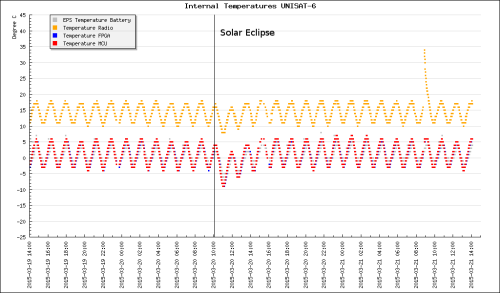During the solar eclipse that took place last 20th of March, UniSat-6 passed very close (around 1600km) from the totality. UniSat-6 monitored the event with its onboard sensors.
The eclipse’s effect was obvious on the satellite: it has been clearly visible from both the thermal and electricity generation points of view.

Telemetry from UniSat-6 during the solar eclipse. The right rise of temperature of the radio is due to a pass over GAUSS ground stations.
Concerning the thermal aspect, the satellite’s internal average temperature dropped by five degrees internally and by ten degrees outside. UniSat-6 is spinning at 8 degree per second, nicely roasting and keeping all the temperatures even. It took the satellite three orbits to recover its thermal balance.
On one hand the satellite accepted the commands, inserted by G.A.U.S.S. operators, to take pictures of the eclipse from orbit, however the camera (located on the outside) needs to be preheated by a ground command in order to correctly boot. Unfortunately on the day, the satellite passed far from the G.A.U.S.S. ground station located in Rome and couldn’t get the command to heat the camera. Although the satellite did switch the camera on at the scheduled time, it didn’t manage to establish a communication as the camera didn’t boot.
On this note, G.A.U.S.S. Srl is building its new ground station (that operates on L-Band & S-Band) to continue the operations and to establish more stable sessions with UniSat-6 and the future satellites that G.A.U.S.S. is currently building (for instance UniSat-7).
